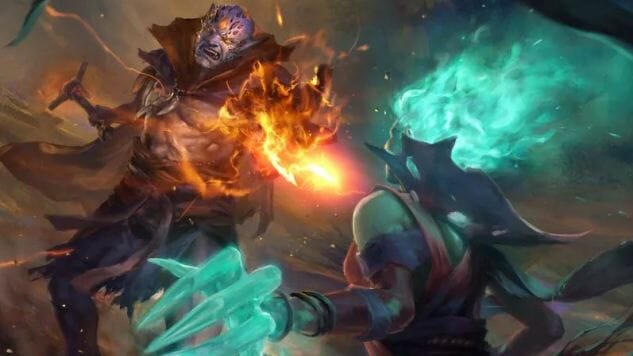Artifact Drags the Collectible Card Game Back to Its Arbitrarily Complex Roots

Digital card games, as a genre, are strange. As virtual recreations of physical cards, they shuffle like cards, they look like cards, they exist in decks like cards, and yet they are wholly liberated from all of the troubles of physical cards. As any Magic: The Gathering player can tell you, physical card games can get hard to manage. Laying out a big board takes up a lot of space, remembering all of the different interactions and static effects on that board can be tough, and the physical manipulation of those cards can get tiresome.
Artifact, the digital card game released by Valve and designed by Magic creator Richard Garfield, sits at the intersection of these virtual capabilities liberated from these material problems. But what no one seems to have considered is that, perhaps, the clunkiness of physical cards could be a good natural limit for keeping complexity low. Artifact is complex. It is too complex. It is not a card game I want to play.
On the surface of things, Artifact looks like other digital or physical deckbuilding games. You create decks with color identities (there are four) that are composed of heroes, creeps, spells, improvements, and items. I am going to try to explain how all of this works for you as briefly as possible, but just know that this explanation is partial. I am not kidding when I say that this game is complex. Here is how it plays:
You have three different lanes. These lanes are each tug of war experiences in which both players are trying to knock down an opposing tower. Winning two lanes wins the game (there is also a mechanic for super duper winning one lane). You play all three of these lanes at once, and it feels like playing three simultaneous games of Magic. However, you only have one hand, and you can only play cards in specific color identities in a lane if you have a hero in that lane. So, for example, if I have a red hero in the middle lane, I can play red spells and creeps in that lane. If I have a red hero and a black hero in the right lane, then I can play red and black spells in that lane.
We go further down the rabbit hole: heroes can die, and when they do, they get a countdown timer before they return to the lanes to be played again. You can give them equipment, and it continues on those heroes after death. These heroes can have continuous or activated abilities that affect the game, and creeps also have these. Improvements allow you to create specific conditions in each lane that differentiate them from one another. Each has its own resource pool, which can vary dependent on cards that are played. Some cards can switch between lanes, and others can be played in one lane and produce effects in others.

-

-

-

-

-

-

-

-

-

-

-

-

-

-

-

-

-

-

-

-

-

-

-

-

-

-

-

-

-

-

-

-

-

-

-

-

-

-

-

-








































